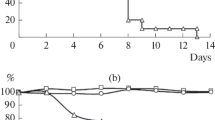Summary
Production of neutralizing antibodies was followed in guinea pigs, rabbits hamsters and mice immunized with crude antigen extracts (AM) from human diploid cells infected with herpes simplex virus type 1. The AM induced relatively high levels of neutralizing antibodies in all four species. The antibodies were predominantly complement-requiring and remained so even after administration of repeated AM doses. With the strains used, the antibody response was predominantly type specific and, surprisingly, the type specificity of sera usually increased after administration of repeated doses of AM. Guinea pigs seemed to be the best responsive animal species. They developed the highest levels of antibodies and complement-nonrequiring antibodies were seen in them earlier than in the other animal species. The dose-response experiments carried out in guinea pigs indicated that after a single dose administration the ratio between complement-requiring and complement-nonrequiring antibodies was dependent on the amount of antigen administered. When AM was given without adjuvant less efficient antibody production was observed than after the administration of the same amount of antigen with adjuvant.
Similar content being viewed by others
References
Appleyard, G., Westwood, J. C. N.: A protective antigen from the pox viruses: II. Immunization of animals. Brit. J. exp. Pathol.45, 162–173 (1964).
Cappel, R.: Comparison of the humoral and cellular immune responses after immunization with live, UV-inactivated herpes simplex virus and a subunit vaccine and efficacy of these immunizations. Arch. Virol.52, 29–35 (1976).
Hilleman, M. R.: Herpes simplex vaccines. Cancer Res.36, 857–858 (1976).
Kärber, G.: Beitrag zur kollektiven Behandlung pharmakologischer Reihenversuche. Arch. Exp. Pathol. Pharmakol.162, 480–483 (1931).
Kitces, E. N., Morahan, P. S., Tew, J. G., Murray, B. K.: Protection from oral herpes simplex virus infection by a nucleic acid-free virus vaccine. Infect. Immun.16, 955–960 (1977).
Kutinová, L., Vonka, V., Řezáčová, D.: Production and some properties of neutralizing antigens of herpes simplex virus. Acta virol.21, 189–197 (1977).
Kutinová, L., Vonka, V.: Determination of virus-specific antigens in extracts from herpes simplex virus infected cells by a51Cr-release inhibition test. Infect. Immun.20, 587–591 (1978).
Řezáčová, D., Barešová, Z.: Experiences in a long-term cultivation of own human diploid cell strains in synthetic medium with growth promoting proteins. Progr. Immunobiol. Stand.3, 73–79 (1969).
Yoshino, K., Taniguchi, S.: Studies on the neutralization of herpes simplex virus. I. Appearance of neutralizing antibodies having different grades of complement requirement. Virology26, 44–54 (1965).
Závadová, H., Kutinová, L., Vonka, V.: Preparation of antisera against the S antigen of influenza A virus by immunization of guinea pigs with internal S antigen. Arch. ges. Virusforsch.20, 422–429 (1967).
Author information
Authors and Affiliations
Additional information
With 3 Figures
Rights and permissions
About this article
Cite this article
Kutinová, L., Šlichtová, V. & Vonka, V. Immunogenicity of subviral herpes simplex virus preparations. Archives of Virology 61, 141–147 (1979). https://doi.org/10.1007/BF01320598
Received:
Accepted:
Issue Date:
DOI: https://doi.org/10.1007/BF01320598




